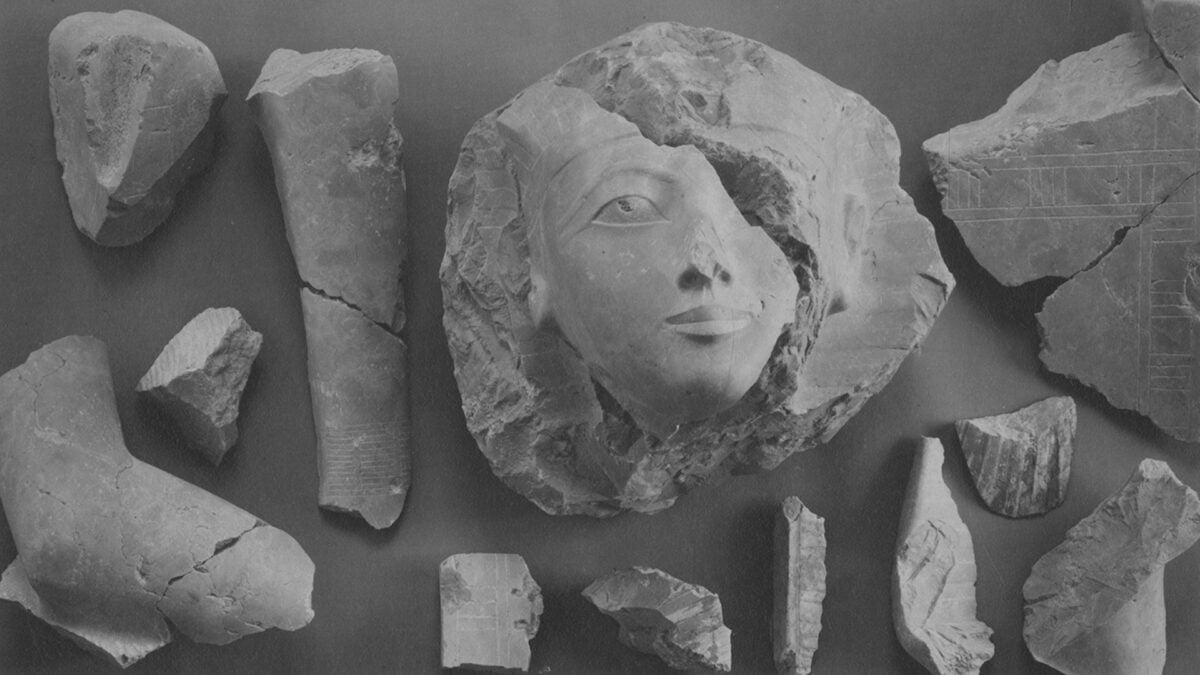
Hatshepsut is likely one of the most well-known figures in historical Egypt. In 1479 BCE, she took on the position of regent on behalf of her younger nephew Thutmose III. By 1473, she started ruling as a pharaoh in her personal proper, changing into one of many civilization’s exceptionally uncommon feminine sovereigns. Over three thousand years later, when archaeologists excavated 1000’s of fragments of her statues, students broadly assumed that her spiteful successor had ordered the entire destruction of her pictures. New analysis, nonetheless, paints a extra nuanced image.
College of Toronto Egyptologist Jun Yi Wong suggests {that a} important a part of the harm triggered to the feminine pharaoh’s statues was the results of historical Egyptian “deactivation” rituals and their use as supplies for different constructions. Although Hatshepsut (pronounced “HAT-shep-soot”) confronted political backlash after her dying, Wong’s analysis challenges the prevailing view that Thutmose III ordered the whole destruction of his former regent’s each illustration with malicious intent.
“Following her dying, the monuments of the pharaoh Hatshepsut (reigned c. 1473–1458 BC) have been topic to a scientific programme of destruction, the most typical manifestation of which was the erasure of her title and picture from temple partitions,” Wong wrote in a study revealed right this moment within the journal Antiquity, of which he’s the only writer. “This act was initiated by Thutmose III, her nephew and successor (sole reign c. 1458–1425 BC), however the motivation behind it stays contentious.”
From 1922 to 1928, archaeologists excavated lots of Hatshepsut’s statues close to her mortuary temple at Deir el-Bahri, Egypt. Given the figures’ broken situations, archaeologist Herbert Winlock of the Metropolitan Museum of Artwork, who led the excavations, recognized them as “maddening relics of Thutmose’s spite,” as quoted within the research.
Nonetheless, Wong claims that “whereas the ‘shattered visage’ of Hatshepsut has come to dominate the favored notion, such a picture doesn’t replicate the remedy of her statuary to its full extent.”
After learning the kind of harm documented in unpublished subject notes, drawings, images, and letters from the Twentieth-century excavations, the Egyptologist factors out that most of the statues have been preserved in a comparatively first rate state, with intact faces. The presumption is that if Thutmose III was hell-bent on destroying Hatshepsut’s reminiscence, he would have been extra thorough in his destruction.
Moreover, Wong argues that a few of Hatshepsut’s statues’ remedy will not be not like that of the statues of different male Egyptian rulers, together with many for whom there isn’t any proof of persecution after dying. Amongst other forms of particular harm, scattered fragments with breaks on the neck, knees, and/or ankles are “believed to be a type of ‘deactivation’ meant to neutralise the inherent energy of the statues,” Wong wrote.
In different phrases, the ritual wasn’t inherently hostile. A few of the harm might have additionally been triggered or worsened by the statues’ reuse as building materials throughout later durations. This, nonetheless, doesn’t fully negate the likelihood that a few of the harm was certainly associated to a political backlash.
“In contrast to the opposite rulers, Hatshepsut did endure a programme of persecution, and its wider political implications can’t be overstated,” Wong concluded in an Antiquity assertion. “But, there may be room for a extra nuanced understanding of Thutmose III’s actions, which have been maybe pushed by ritual necessity moderately than outright antipathy.”
Finally, the suggestion that Hatshepsut was handled like different deceased pharaohs after her dying, regardless of the persecution, makes her rise to the throne as a girl much more extraordinary.
Trending Merchandise

NETGEAR 4-Stream WiFi 6 Router (R6700AX) – AX1800 Wi-fi Pace (As much as 1.8 Gbps) | Protection as much as 1,500 sq. ft., 20 gadgets

CHONCHOW LED Keyboard and Mouse, 104 Keys Rainbow Backlit Keyboard and 7 Color RGB Mouse, White Gaming Keyboard and Mouse Combo for PC Laptop Xbox PS4 Gamers and Work

HP Portable Laptop, Student and Business, 14″ HD Display, Intel Quad-Core N4120, 8GB DDR4 RAM, 64GB eMMC, 1 Year Office 365, Webcam, RJ-45, HDMI, Wi-Fi, Windows 11 Home, Silver












